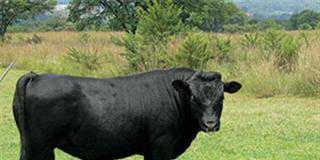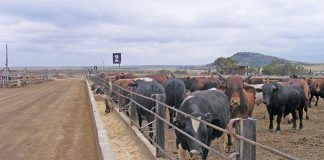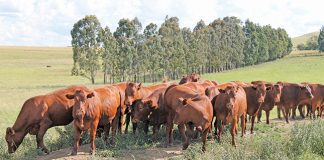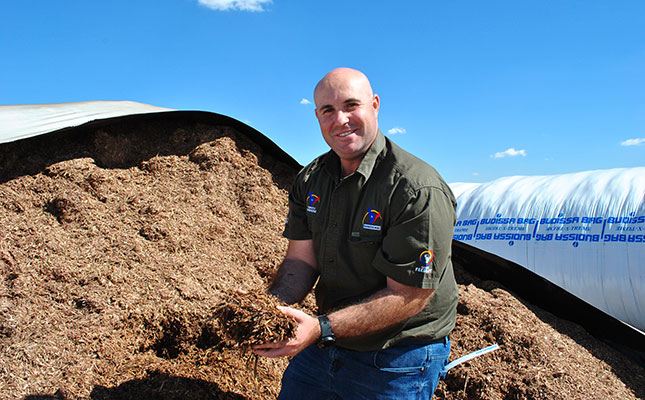
Photo: Pieter Dempsey
Jarren Hurwitz, who owns and runs Hurwitz Farming with his brother, Simeon, did not grow up on a farm.
He and Simeon were city folk, he explains, with no farming background and little knowledge of agriculture.
Despite this, they launched their farming operation in 2010.
When they started on the farm, which is near Davel in Mpumalanga, the property was not in a productive state, according to Hurwitz.
However, over the years, they have built a successful commercial operation that has expanded to include several divisions.
At the deep end
“It was a baptism by fire. We threw ourselves in at the deep end,” recalls Hurwitz, adding that when they took over the farm it had infrastructure for a small feedlot and very few animals.
These included a handful of commercial breeding cattle, and a small cropping operation producing maize and soya bean.
Some of the cattle on the farm were the remainders of one of the pioneering Boran studs in South Africa.
Their performance and breeding records, however, were woefully out of date. Despite this, one of the first decisions the brothers made was to revitalise the stud.
In addition, they started scaling up other operations on the farm such as the commercial beef breeding herd, the feedlot and the cropping division.
According to Hurwitz, they now run one of the largest registered Boran studs in the world, with 3 000 animals.
They have also grown the cropping division and now produce maize, sorghum and soya bean on about 2 500ha.
Apart from their primary farming activities, the brothers have also invested in a registered quarantine centre, an auction house and a meat distribution business.
Silage
One of their most recent business ventures has been a silage contracting service that operates countrywide.
For half of the year, they produce bagged silage on farms in the summer rainfall region, after which they move their harvesting and bagging equipment to the winter rainfall region.
READ Expert tips on producing better silage
Hurwitz explains that to produce feed for their cattle operation, they were already producing silage, even though they did not have much knowledge of best practice or how to ensure quality silage production.
They were using what he calls “the old method” to produce maize, sorghum and oats silage. This involved using piles stacked directly on the ground, compacting these with tractors, and covering the material with plastic sheeting.
This all changed, however, after the brothers met the representatives of a company that sold inoculants for silage production.
“When the two consultants from the company visited the farm in January 2017 to look at our silage, I could immediately tell from the looks on their faces that the results from the samples they took would not be encouraging. It was at that moment that I realised we had to change the way we were doing things.”
Hurwitz went back to his office and immediately booked a flight to Germany to learn more about silage bagging.
“At the time, I’d heard about the concept of silage bagging but had always thought it was just a neater method of storing silage. I had no idea about the benefits this method offered for improving the quality of the silage.”
Very soon after his return, he ordered their first silage bagging machine and started learning all he could about the science behind producing good-quality silage, adding to his knowledge of the subject that he had picked up in Germany.
Myth-busting
Hurwitz also enlisted the help of an independent silage consultant. Together, they used a 1,2m-long thermometer to take daily measurements of the temperature at which the silage in their first bagged batch was fermenting.
The common theory is that silage needs to heat up to a temperature of above 30°C to trigger fermentation, but they quickly realised this was not the case.
“The first thing we discovered was that the maximum temperature recorded inside the bag was 18°C and that the temperature fluctuated between that and 14°C. The lesson here is that silage doesn’t have to heat up to a high temperature for fermentation to take place.”
READ Towards climate-smart livestock farming
After comparing the process that happened in the silage bag to a conventional concrete silage bunker, they found the temperature difference between the bag and the pile in the bunker was at least 12°C.
They also tested both silage samples for yeast, mould count and organic matter loss. The cooler core temperature in the silage bags creates a far more stable product, with a longer shelf life.
The lack of excessive heat means that the energy and nutritional quality of the feed is better retained as these degrade rapidly when silage heats up to a high temperature.
The yeast count in the silage bags was measured at 890 colony forming units (CFU) per gram, while the count in the silage that was being produced in the concrete bunkers was 560 000 CFU/g.
Yeast, Hurwitz explains, is an indicator of negative microbial activity, which degrades the feed quality of silage and heightens the risk of toxins being present in the feed.
“Poor-quality silage with high levels of microbes and toxins cause poor feed conversion for beef and dairy cattle and can rapidly cause health problems, including reproductive problems, in animals eating it,” he says.
In addition, increased yeast levels are a marker of poor oxygen removal in silage and an indicator that energy levels in the silage are lower than they could be.
Once silage is exposed to oxygen for too long it essentially decomposes into compost.
During this process, says Hurwitz, much of the organic matter of the silage is lost and feed value is eroded.
“The pace at which silage erodes to compost is an indicator of what is termed the stability of the silage. Bagged silage has a very high intrinsic level of stability because of the exceptionally fast oxygen cut- off at the bagging stage as well as the relatively small surface area, which makes the stability characteristics much more secure.”
In two trials where they compared bagged silage with bunker silage, the brothers found that the former showed a saving of 45% of organic matter loss over a five-day aerobic stability testing period.
Silage bagging
Hurwitz says the most common misconception about making good-quality silage is that compaction is the most important process.
“Compaction is only a means to remove oxygen from the silage. It’s the removal of oxygen as quickly and efficiently as possible that is the key element to making quality silage. Equally important is the rapid drop in pH in order for fermentation to take place.”
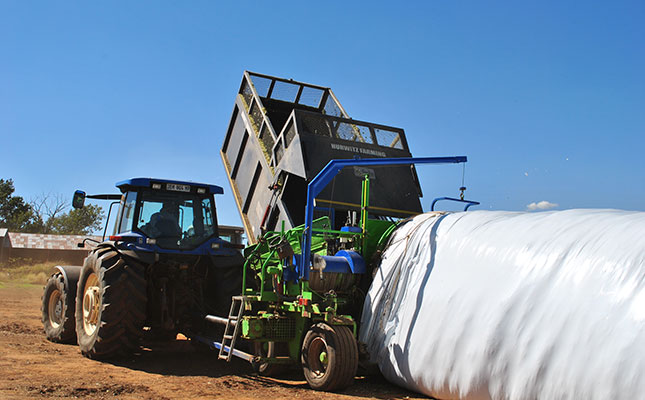
When using silage bagging technology, the oxygen is removed almost instantly and fermentation thus takes hold rapidly.
The bags are made from seven layers of recyclable virgin plastic materials and have a micron strength of 240.
According to Hurwitz, the process of producing quality silage should start with measuring the moisture of the crops being cut for silage.
If the ground and crops are too wet, the machines struggle to operate effectively, and plant material that is too wet compromises silage quality.
Most modern forage harvester machines, once correctly calibrated, can give a reasonable indication of the moisture content as the crop is being cut.
The Hurwitzes use Claas forage harvesters with patented Shredlage technology. This involves the use of differentially sized and rotating rollers, where one is larger than the other and each moves at a different speed, to produce kernel-processed maize silage that is both ripped apart and cut.
The silage is usually cut to a longer length than usual, producing softer, less coarse silage material, but Shredlage technology also enables shorter lengths to be cut.
Bagging increases the window for cutting
“Something we’ve disproved is that once silage becomes too dry, you can’t ensile it,” says Hurwitz.
This might have been true with the conventional method, which does not allow for successful ensiling when the material is too dry as it cannot be adequately compacted.
However, bagging silage allows the farmer a considerably larger window for cutting, reducing the risk of having to cut at an early stage when the material is too wet.
Bagging therefore gives far more opportunity to make better-quality silage as it dramatically mitigates the timing risks of being too early or too late.
Hurwitz points out that the target for maize silage has always been to cut silage when the crop is at 35% dry matter. However, for every 1% increase in the amount of dry matter (up to a point), the more starch there is in the silage, which improves the nutritional value.
“We’ve successfully made silage in the bag at 61% dry matter. We analysed it and it made great-quality silage.”
In practice, he adds, no farmer would aim for that amount of dry matter, but knowing that the system allows for such a large percentage of dry matter provides a bigger window during which to cut silage.
According to Hurwitz, the simplest yet most effective way to test the moisture content of silage is to take a handful of chopped silage, weigh it, put it into a microwave oven to dry it out, and then weigh it again. The difference in weight after repeating this process a few times will provide an accurate indication of the moisture content.
After being bagged, the silage will be ready for consumption after a few weeks and can be kept in sealed bags for years without compromising the quality.
During Farmer’s Weekly’s visit to Hurwitz Farming, a 76ha block of irrigation maize was being cut for silage.
The average yield for these lands was 54t/ha, and the entire process, from cutting to transport to bagging, using two forage harvesters, several trailers and two baggers, was completed in under two days.
Benefits of better silage
Hurwitz says that they feed a high-energy, dense ration in the feedlot and rely on silage as a highly digestible fibre source.
“We don’t make use of any other roughage in the rations.”
Since they started using bagged silage, the health and performance of animals in the feedlot has improved in leaps and bounds.
Digestive challenges and the occurrence of bloats have been reduced to exceptionally low levels, while growth performance in average daily gains has improved.
“We’ve also begun feeding silage to our breeding cattle in the winter months, instead of relying only on hay bales,” says Hurwitz.
The silage is given as a supplemental feed together with licks and crop residue in winter.
Since the brothers began replacing much of the dry hay with silage, they have seen an improvement in the condition of their breeding cattle, and an increase in the animals’ fertility and conception rates.
Email Jarren Hurwitz at [email protected].
RELATED: Watch Argentinian cattle farmer, Miguel Pertino explain the mechanics of feeding cattle from a 65m long silage bag with 3 000kg/m









